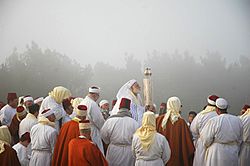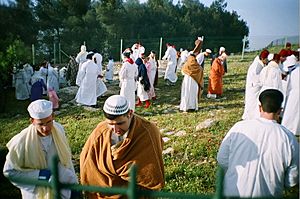Samaritans facts for kids

Samaritans on Mount Gerizim during Passover
|
|
| Total population | |
|---|---|
| 820 (2019) | |
| Regions with significant populations | |
| Samaritan Community Populations | |
| Israel (mainly in Holon) | 415 (2017) |
| Mount Gerizim | 381 (2017) |
| Religions | |
| Samaritanism | |
| Scriptures | |
| Samaritan Torah | |
| Languages | |
| Modern vernacular Hebrew, Arabic Past vernacular Arabic, preceded by Aramaic and earlier Hebrew Liturgical Samaritan Hebrew, Samaritan Aramaic, Samaritan Arabic |
|
| Related ethnic groups | |
| Jews Other Levantines and Semitic peoples |
|
The Samaritans are a small group of people who live in the Levant, a region in the Middle East. They believe in one God, similar to Judaism. However, Samaritans use only the Torah as their main holy book.
Today, there are just over 800 Samaritans in the world. Most of them live in two main places: Holon in Israel and Nablus in the West Bank.
Contents
Who Are the Samaritans?
Samaritans believe they are descendants of ancient Israelite tribes. These tribes include Ephraim and Manasseh, who were sons of Joseph. They also trace their family lines back to the Levites. These groups lived in ancient Samaria, which is now mostly the West Bank.
Samaritan tradition says their split from other Israelites happened long ago. They believe it was during the time of the priest Eli. They see themselves as keeping the original Israelite traditions.
What Do Samaritans Believe?
Samaritans follow a religion called Samaritanism. This religion is very similar to Judaism. Samaritans believe their way of worship is the true ancient Israelite religion. They say it was kept by those who stayed in the Land of Israel.
They believe this happened before the Babylonian captivity. They see Judaism as a related but changed religion. Samaritans believe that Mount Gerizim is the holiest place for worship. They think it was chosen by God when Joshua entered Canaan.
- Holy Place: The main difference between Samaritans and Jews is about where to worship God. Jews believe it's the Temple Mount in Jerusalem. Samaritans believe it's Mount Gerizim.
How Has the Samaritan Population Changed?
The Samaritan community was once much larger. However, their numbers dropped a lot after several events.
- Revolts: There were bloody fights called the Samaritan Revolts. These happened around 529 CE and 555 CE against the Byzantine Empire. Many Samaritans were killed or forced to convert.
- Conversions: Some Samaritans converted to Christianity during Byzantine rule. Later, some also converted to Islam.
- Small Numbers: By the Middle Ages, there were only about 1,900 Samaritans left. This was estimated by a traveler named Benjamin of Tudela.
Where Do Samaritans Live and What Languages Do They Speak?
Today, Samaritans live mainly in two places. One is Qiryat Luza on Mount Gerizim. The other is Holon, a city near Tel Aviv in Israel.
- Modern Languages: Most Samaritans in Holon and Qiryat Luza speak Hebrew and Arabic.
- Religious Languages: For religious ceremonies, they use special forms of language. These include Samaritan Hebrew, Samaritan Aramaic, and a form of Arabic. All these are written using the Samaritan alphabet. This alphabet is different from the modern Hebrew alphabet.
Samaritans in Modern Society
Samaritans have a special religious status in Israel. Sometimes, people convert between Judaism and Samaritanism, often because of marriage.
- Jewish Recognition: Some Jewish religious leaders see Samaritanism as a branch of Judaism. However, the main Jewish religious authority in Israel requires Samaritans to formally convert to Judaism to be fully recognized as Jews.
- Military Service: Samaritans who are Israeli citizens must serve in the Israel Defense Forces. Those who have both Israeli and Palestinian citizenship, living in Qiryat Luza, are usually excused from this service.
Related pages
Images for kids
-
Mosaic from a Samaritan synagogue (Israel Museum).
See also
 In Spanish: Samaritanos para niños
In Spanish: Samaritanos para niños


















